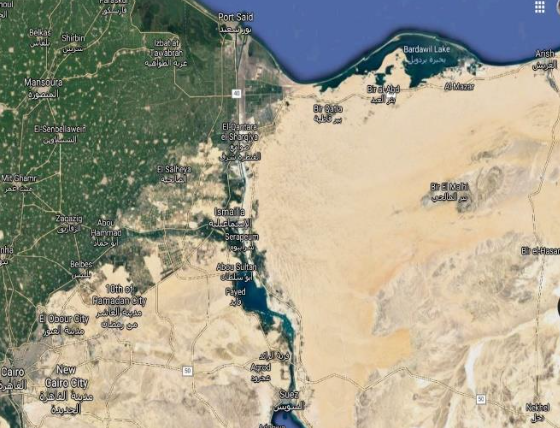By Gunjan Sharma
Cairo, Mar 26: Oceans and seas play a key role in connecting our world when it comes to transportation. Ocean traffic primarily consists of cargo (goods transported by air, land, or water) transported in huge ships loaded with shipping containers. Ten percent of sea cargo passes through the Suez Canal. A canal is an artificial waterway constructed for transportation and irrigation purposes. The Suez Canal passes through Egypt and connects the Mediterranean Sea in the north and the Red Sea in the south. It is 192 kilometers long and 300 meters wide at the narrowest point. Along its route, it passes Great Bitter Lake.
The canal was built as an alternative sea route connecting Europe to India and Australia without having to go around Africa.
It is a shortcut which reduced the distance to be traveled by ships from 20,900 km to 12,000 km. It is one of the busiest sea routes in the world with about 51 ships passing through it per day. Ships take sixteen hours to cross it.

From Twitter of @AirbusSpace
History
The idea of a canal passing through Egypt has existed for thousands of years. However, it was difficult to maintain since desert sand would reclaim the dug canal. The construction of the canal in its present shape and form was started in 1859 and completed in 1869. It was built and maintained by the Suez Canal Authority which was headed by Ferdinand de Lesseps and owned by British and French shareholders. Egyptian labourers built it with great difficulty. Post completion, it played a key role in shaping global events including colonialism, the world wars, global trade, and more. Let’s also remember that building the canal came at huge environmental costs since the ecology of two seas was impacted when they got connected.
In 1967, the ownership of the Suez Canal Authority was transferred to Egypt after a brief war and intense discussions at international diplomatic levels. Intervention from the United Nations helped in restoring peace in the region.

Importance
Today, Egypt receives revenue from ships passing through the canal. Ships of all types and countries are allowed to pass through it in times of war and peace. One of the key goods transported through it is crude oil exported from the Arabian Gulf to Europe. In keeping with the increasing sizes of ships, the canal has also been expanded several times (in breadth) since its construction. Even otherwise, constant dredging is required to prevent unnecessary sand deposition at the bed. The Suez Canal is also the most easily recognized manmade structure from space.
Recent Events
On March 24, 2021, a cargo ship named Evergreen got stuck in the canal, leading to a blockade and traffic jam. The ship was navigating through the canal’s narrowest point when a strong gust of wind dislocated it. The ship is longer than the height of the Eiffel Tower, so removing it has been quite challenging. This has led to some concern in economic circles since the shipment of goods and oil is blocked. Efforts are on to dislodge the ship and restore traffic.


